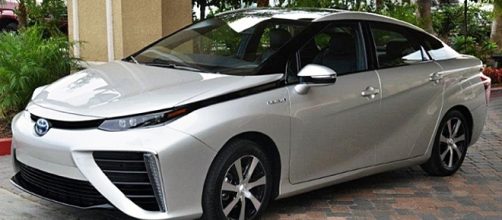Energy companies from Abu Dhabi will be working with Toyota to showcase its newest hydrogen-powered vehicle for use in the United Arab Emirates (UAE). The companies involved include Adnoc, Masdar, Al Futtaim Motors, and Air Liquide (an industrial hydrogen provider). If successful, they plan to roll out more hydrogen-fueled cars to help the UAE lower emissions and meet the targets set by the climate accord.
They are also constructing a refilling station that can charge the fuel cells, which begins in May. Once completed, Toyota’s Mirai (pronounced Me-Rye) will undergo tests for safety and driving issues.
In the U.S., there are about 1,000 Mirai (all in California) with an MSRP of $35,000, which is substantially cheaper than Tesla’s government-subsidized electric vehicles.
Concomitantly, the Masdar Institute will study the viability of creating an all-hydrogen society and cost-effective hydrogen production. Government agencies can obtain short-term leases to the new vehicles to understand how fuel cell vehicles (FCVs) work. In 2016, mechanical testing of the Mirai was undertaken in the UAE and a demo refueling station was built at Al Futtaim in Al Badia.
Toyota Mirai Driver Comes Clean About His Hydrogen-Powered Car https://t.co/J67DEXZZZ7 #NYSE_TM pic.twitter.com/YPIltyfjJe
— NeverNumberTwo (@NeverNumTwo) January 17, 2017
Zero-emissions vehicles
An FCV provides power when the compressed hydrogen gas reacts with oxygen from the air, which generates electricity to power the engine.
Unlike electric vehicles, the FCVs fill up just like regular cars and aren’t weighed down by heavy lithium batteries. Right now the 2016 Mirai gets 502 kilometers (312 miles) per fill-up. That’s substantially farther than even the most robust electric vehicle (EV). The Mirai gets 66 mpg with an annual fuel cost of $1,250.
Compared to traditional gasoline-powered cars, the Mirai is classified as a zero-emissions vehicle.
The Emirates may seem like an unlikely place to test a hydrogen-powered vehicle given its oil and natural gas reserves. But after ratifying the Paris Climate Agreement, they were committed to lowering greenhouse-gas emissions that hasten climate change. Vehicles in the UAE produce 22 percent of all carbon dioxide emissions.
Hyundai to Release New Hydrogen-Powered Car in 2018 https://t.co/8aBctzfh5b #Hyundai #Ecofriendly #Hydrogen pic.twitter.com/dxcPnsqdbM
— Korea_Insight (@ZoomInKorea) July 29, 2016
Toyota has company
Carmaker Hyundai will also be debuting its next generation of hydrogen-powered cars at the Winter Olympics in February 2018. Hyundai hopes to show off its second generation of hydrogen cars to the press in attendance. Hyundai was also the first car company to mass-produce hydrogen-powered automobiles.
Hydrogen will also be showcased at the 2020 Olympic games in Tokyo, Japan. The Olympic village, which houses the training facilities, will run entirely on hydrogen power. The governor of the Tokyo Metropolitan Government, Yoichi Masuzoe, has already allocated $350 million to subsidize building hydrogen fueling stations and fuel cell cars prior to the Olympics.
Electric Vehicles Emit More Pollutants Than Fossil Fuel-Burning Cars, Says Study https://t.co/aeTDiishSZ via @dailycaller
— MWAG (@Charlielincs) October 4, 2016
Elon Musk: hydrogen critic
Elon Musk, Tesla’s CEO and EV maker, has a problem with hydrogen-powered cars: he doesn’t think they’re clean enough even though they only emit water upon combustion. Musk said the collection of hydrogen to power these new cars comes from natural gas, while only four percent comes from water. With advancements in fracking unlocking natural gas across the world, accessing hydrogen has become even more cost-effective.
And recent studies show that e-vehicles aren’t as clean as most people think. One study showed that non-exhaust emissions from brakes, tires, and roadways are higher than exhaust emissions in gasoline-powered vehicles.
And EVs get their power mostly from fossil-fuel powered plants, hardly a clean endeavor. But that hasn’t stopped the Obama administration from favoring the EV industry over hydrogen, the latter his predecessor was actively pursuing.

